But that ended in a sort of "coitus interruptus". The car, Dani said, had a very good compromise between absorption capacity and body movement control, and its engine was muscular in the mid-range to offer good recoveries. But attacking the corners at 100% was not an injection of endorphins and dopamine. It was a fast car, yes, but not a machine at the level of a Fiesta ST when it came to having fun linking corners.
The fact is that among my friends at the Nissan Technical Center I had already heard that, after testing the various final tuning of the car, they had opted for that way, to offer a better compromise for the "real" end customer. And the fact is that the buyer of a Juke Nismo did not have the profile of a "pure burnout". One person at the Centre told me that "you know what the chassis is capable of, so you can imagine that with a different tuning it could bring out smiles".
This more radical tuning, originally discarded, eventually found its way to the market, in the form of the Juke Nismo RS. And this is our protagonist of this test.
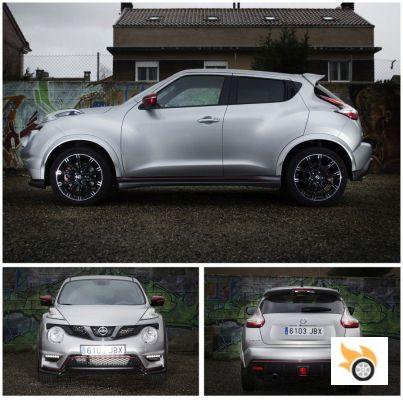 Compared to the conventional Juke Nismo, the RS adds another tuning of springs and dampers, more power (213 hp CVT 4×4, 218 front-wheel drive manual) and in the front-wheel drive manual version, also more torque, going up to 280 Nm.
Compared to the conventional Juke Nismo, the RS adds another tuning of springs and dampers, more power (213 hp CVT 4×4, 218 front-wheel drive manual) and in the front-wheel drive manual version, also more torque, going up to 280 Nm.
The "problem" is that the all-wheel drive version, which on paper offers quantitative advantages such as intelligent torque distribution to achieve effects in the yaw of the vehicle, must be ordered by obligation with the continuously variable gearbox (the hated CVT), which in turn is limited to 250 Nm of torque, so the variants with all-wheel drive are left in torque in the same figure as the "normal" Nismo.
The brakes also change, with larger discs, bitten by Brembo calipers, while the steering receives changes in its tarado, Nissan account.
Design
Although designed in the UK, everywhere you look it screams "manga".
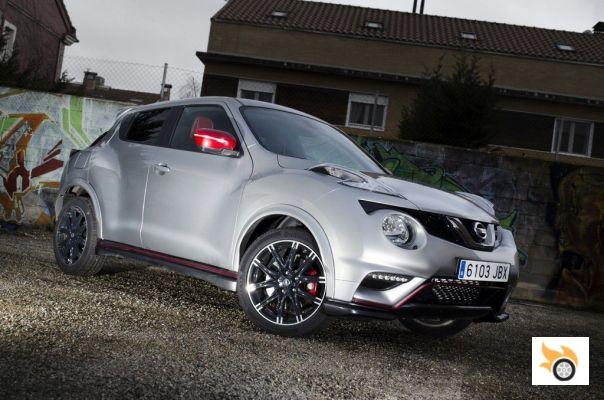
With the lesson well learnt, we get in front of the car. Dani already gave you his description back in the day, and the truth is that the RS hardly differs in any way from the "normal" Juke Nismo. The somewhat dark grey colour of the test car, however, looks spectacular. It is just the same tone used in the GT-R, but in the curvy and voluptuous shapes of the Juke just sitting great, playing with the brightness and shadows to mark muscle.
To each his own, but to me it's a car, the Juke, that aesthetically fits me and works like a charm. It is different from all the others. It has personality and character.
And best of all, despite being conceived by Nissan's UK-based design studio, it screams "manga" from every angle. It's a car that just by looking at it you know its origins are Japanese.
Many other firms have gone after Nissan's idea, offering crossovers in the B-segment, but none have gone for such a strong aesthetic personality as the Nissan.
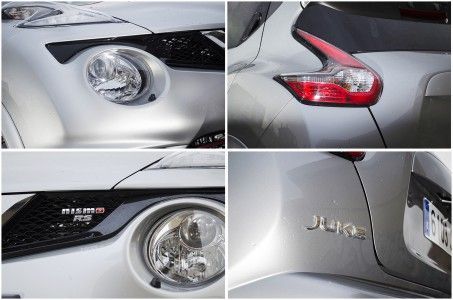 The Nismo body kit, the red detailing, the contrast with the dark grey plastic against the grey of the rest of the bodywork, the two-tone wheels... It all plays into the fact that, together with the spoiler on the tailgate, you're looking at an unmistakable car.
The Nismo body kit, the red detailing, the contrast with the dark grey plastic against the grey of the rest of the bodywork, the two-tone wheels... It all plays into the fact that, together with the spoiler on the tailgate, you're looking at an unmistakable car.
Pretty by traditional metrics? No. It's clearly not "beautiful like an Alfa Romeo 33 Stradale". But at least it's not just another clone for the tribe. Despite the aforementioned body kit, the car's angle of attack isn't too much worse, so there's no need to be afraid of brushing the front spoiler on access to garage ramps or speed bumps.
By the way, a very heard comment during the days we had the car: The two-color rims, although they work on paper, they look "a bit toy-like" in real life. That they want to look like they have double spokes on each arm and then don't have them might have something to do with it.
Cabin
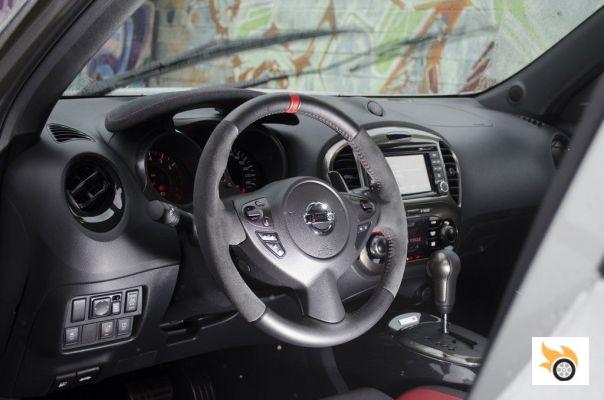
One of the problems of the conventional Juke is when opening the door. And it's still present in the Nismo RS. The design of the dashboard is "acceptable", but the choice of materials, the finishing of the same, and the adjustments that have each other, are far from the level shown in the competition that has this car in the B segment, more when you consider that the test unit was "the top of the range".
For example, the trim around the central screen of the infotainment system, which wants to simulate carbon fiber, looks like a toy. The climate control screen, which doubles as a "toy" to select the driving mode, looks "Game Boy '90s", while the automatic transmission lever and its "grille" also looks a decade or two old.
If you forget about these aches and pains, you'll be able to find strengths too. The Recaro CS chosen for the occasion are simply great. We've been testing them for years in many different cars, from Clio RS to Corsa OPC, Meganes, Fords, and a lot of other cars. And we've always loved them. It was not going to be any different this time.
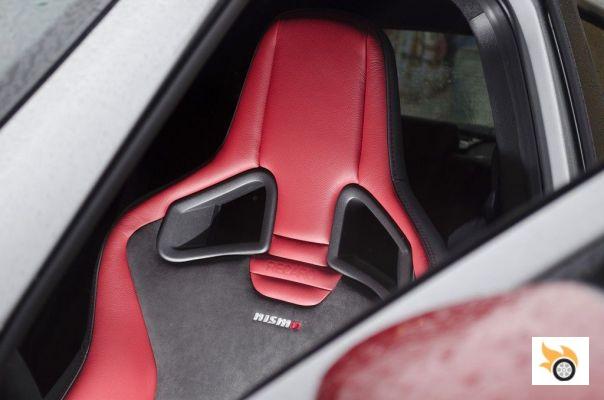
The Recaro CS chosen for the occasion are simply great.
The partially alcantara-wrapped steering wheel is a delight to grip, even if it's a source of dirt in the medium to long term if you lend the car to anyone with sweaty hands.
Ergonomics are acceptably resolved. The controls fall where they should, and the automatic transmission paddles (the test unit was the 4×4 with CVT, which we'll talk about below), are attached to the steering column, and large, something that comes in handy when you try to downshift with the car into the curve.
The space in the front seats is more than enough, and visibility, although somewhat compromised towards the rear, is supplemented with Nissan's brilliant "360" overhead camera system, which makes it easy to execute any parking maneuver.
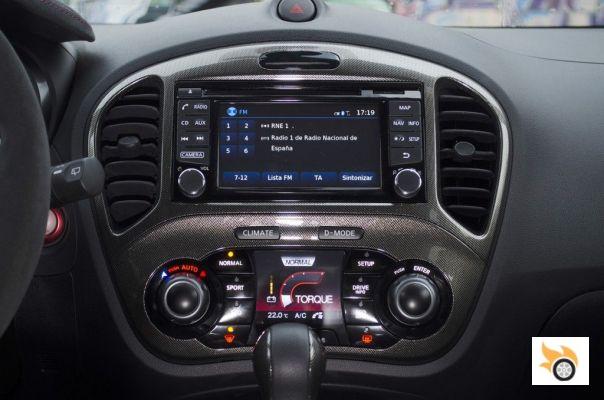
As for space... This is a Juke, and you know it's not a roomy car for its class. Despite its exterior dimensions, the rear seats are tight on legroom (the Recaros don't help, being very close to the ground and making it difficult to get your feet under them).
The fact of having a rear differential and a multi-link rear suspension also has to do with the lack of space in a trunk that is too tight when you look at the volumes in which a Clio RS moves, for example. It's 207 litres for the Nissan, compared to 300 for its French cousin, which is a notable difference.
Technique
One of the vital aspects of the Juke Nismo RS compared to the normal one, when you buy it in front-wheel drive, is that a self-locking differential is included in the front axle, to make better use of the engine's torque, and also to help you get the nose more decisively into the trajectory.
But our test Juke was a 4×4, and that changes everything. In our case, the car offered three modes of operation: a pure front-wheel drive mode, an all-wheel drive mode with vectoring, and a "normal" all-wheel drive mode. The front-wheel drive mode should be used for lower fuel consumption, the vectoring all-wheel drive mode for more graceful driving dynamics, the "normal" 4×4 mode for... well... for a "conventional" all-wheel drive car.
On paper, the idea of an all-wheel drive sports car with intelligent torque distribution, capable of sending more torque to the outside wheels on the corner, and re-sending torque to the rear axle when the front is not able to handle the torque, is interesting. At the end of the day, we're looking at a sort of miniature GT-R. Or to be fairer, a sort of scaled-down Group A rally car. Of course, the Juke isn't so small... It's 4.13 metres long, more than a Delta Integrale, for example.
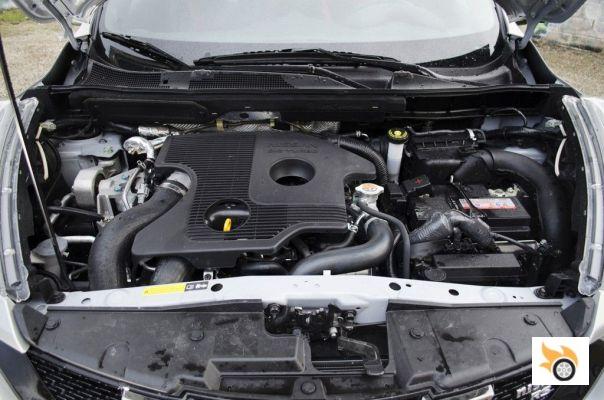
With all-wheel drive, the CVT is a must. Nissan loves it, we're starting to hate it.
Indissolubly associated with this type of traction is the CVT gearbox. Nissan loves it, we're starting to hate it. Yes, the engineer in me will remind you that it's the optimal solution for fuel efficiency. With such a gearbox (like a moped with no gears), what you get is the engine working at constant revs, in its sweet spot of efficiency or muscle, to respond to the demands of the driver. What the variator does is to continuously modify between infinite gear ratios the rule that regulates how many turns the wheels make for each turn of the engine crankshaft.
So energy efficient is this system, and so optimal is that in Formula 1 all cars would use it, if it were not because it is forbidden by regulation, after Williams demonstrated in some tests that it was ideal, and the FIA was scared of what was coming.
But the problems of the CVT are not related to its technical concept, but to the sensations it produces. But that's what we'll talk about below.
Start and move with it
Without taking the key out of my pocket, I open the door and start the engine with a touch of a button. Nissan says that in the Nismo RS the exhaust is a bit rougher than in the normal Nismo. Personally I hardly notice any difference, being the acoustic comfort more than acceptable. It is not a car that sounds fat and has an exhaust present at idle.
I put the gearshift in position D with the lever, whose finish, movements and finishes are not up to what I would expect in a car of this price.
I activate the zenithal vision system to get the car out of its parking space. It's child's play, an invention that all manufacturers should apply to their cars. Just release the brake and the car starts to move with a touch of the accelerator. It's a bit tricky to manoeuvre with precision, as the car goes from stationary to jerking too abruptly, so when you're squeezing for the last few millimetres of space in a car park you have to be careful not to get hit by the cars around you.
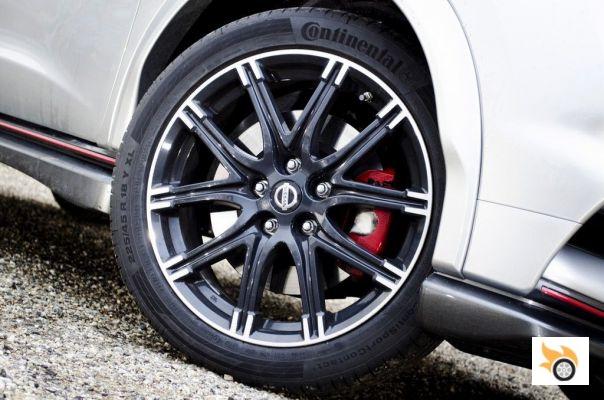
The brake pedal feels a little strange in its feel and travel, with a spongy first phase, and then the braking power coming later.
I roll through the city streets to find a car that, thanks to its somewhat elevated driving position, is easy to handle and place in spaces, although the three-quarter view to the rear could be improved.
The suspension is a pleasant surprise. I expected it to be harsh and dry to compromising levels in this RS. This is not the case, and manhole covers, speed bumps and other council giveaways go pretty much unnoticed. The gearbox allows you to forget about it, the truth, and it is in these urban movements when you are grateful to have an automatic transmission of this type, although in stops for traffic lights or roundabout entrances I still find something strange with the brake pedal. By the way, speaking of entering roundabouts, as happens in other Nissanes, the rearview mirror creates a problem of visibility to access them, being just at the angle where you expect to see cars coming.
Urban consumption with this change is getting out of hand.
Urban consumption with this gearbox is out of hand. Indeed, the CVT is the most energy-efficient solution, but the throttle response settings, our taste for right-pedal steering and the all-wheel drive (not to mention the two-wheel drive mode) make it difficult to see a fuel consumption of less than 12 litres for the turbocharged 1.6-litre direct injection 1.6-litre petrol.
Going shopping, or taking the little one to the pediatrician show that the boot of the Juke, as in the other versions, is not to shoot rockets when you take a baby carriage on board. Otherwise, it's a perfect urbanite, which also happens to look good.
After discovering it on the streets of Madrid, I set off on the road with it, first on the motorway. Juke likes to stretch its legs. It doesn't have the small car syndrome (it's not a small car in absolute terms, but the segments have gone crazy...), and it willingly accepts to drive as fast as you want. In fast motorway bends it is unflappable. It swallows potholes as if nothing, with great comfort, comfort helped by good aerodynamic and engine insulation.
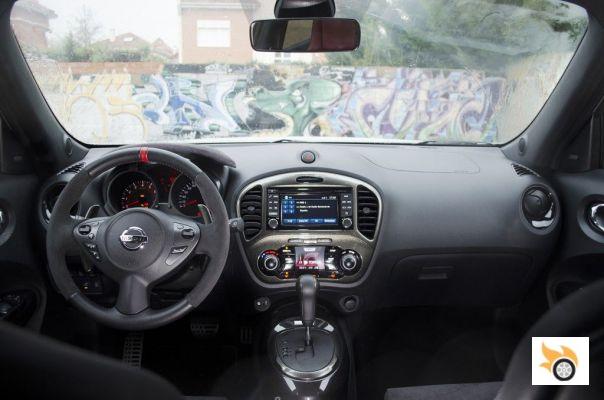
What surprises me here is that although it's a car with 214 horsepower, it doesn't seem as fast as I expected. The 0-60 in eight seconds tells you it's not a time breaker. The CVT helps with the quicker recoveries (80-120 in five and a half seconds or so), but it's curious that it's slower than the regular front-wheel-drive Juke Nismo, which managed to do the same recovery in half a second less. At least it's quicker by this measure than cars like the Fiesta ST, even if it doesn't sound like it because of the variator's sound and the progressive engine delivery.
At least the consumption is going down, being able to average around seven and a half liters long in these conditions. As the miles go by, you understand that it's a good fast utility car, but it's not a ballistic GTI in these conditions. The engine character isn't looking for it either, with a progressive delivery, even if it has the torque "a little higher" than seen in the Clio RS. In any case it's a very progressive engine, further sifted by the CVT gearbox to achieve a very linear and non-explosive delivery, which further filters out the acceleration sensations.
With this learned, I set myself the goal of doing the route of the ports that I always use to test each car, with special dedication to sports cars. Unfortunately, the weather hasn't been on our side for weeks, and during the whole week we spent with the Juke Nismo RS, there was no way to find dry tarmac to push it to its limits in conditions without humidity.
Be that as it may, I set the "sport" mode on the center console, and program the gearbox to manual mode. Theoretically this allows you to play with eight fixed gear ratios, as if it were a sequential gearbox. I hit the road. The first braking already reveals much of the cake of this sporty Juke.
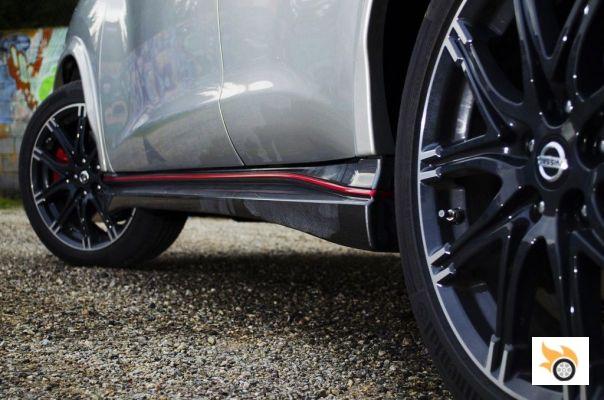
As it had happened in the city, but more markedly on curvy roads, the pedal feel blurs our perception of how to play with the brake metering. Too spongy and too long in its travel, it acts on anchors that are powerful, but difficult to judge.
Two pulls of the left cam to downshift reveal to us that, as is always the case with this type of gearbox, "fixed" gears are not such. There is a certain level of "slip" between revs and wheel movement, but this will be more pronounced when accelerating.
With the car at the right speed, I mark the entrance of the curve with the steering wheel, and I find a pleasant surprise. The pitching of the car is little marked, despite its height. The roll, with the car still resting on the brakes, is not marked either. Despite the height of the center of gravity (this is an SUV), the car takes little time to register and mark a firm support, even if it is at the cost of leaning more than any of the sport utility vehicles you can imagine.
Once it's on the ground, if there's a huge pothole in the middle of the line, the Juke will swallow it without a care in the world, without breaking the trajectory.
But what if we overcook the corner entry? Obviously, understeer will make an appearance. Minor miscalculations, with the car already leaning over, you can try to tackle them by playing with the throttle load, with sudden twitches of the right pedal to yaw the rear, but you won't get anywhere. The ass of the Nismo RS doesn't want to get into the corner, it doesn't round the corner, and it's also partly the fault of the CVT gearbox, that when you play with the throttle in an abrupt way, it keeps changing gear ratios (even with the manual gearbox).
The car's traction capacity is faultless.
And that's because this continuously variable gearbox kills the direct connection between accelerator pedal and wheel movement, so if you're one of me, and you like to control precisely how much torque is reaching the wheels at any given moment, feeling it with your right foot, you'll find yourself lost with this car... And then there's the "kick down" switch located at the end of the accelerator pedal travel, which is annoying when you play with the full power of the car, creating an artificial stop that further complicates things.
Once the apex is reached and it's time to put torque to the wheels to get out of the corner quickly, the Juke Nismo RS finds its competitive edge over its rivals. With the wet (and even snowy) asphalt that we had during the test days, the car's traction capacity is impeccable. Even if you overdo it with the right pedal, the all-wheel drive and the emulation of the rear self-locking to play with the car's trajectory ensure that it doesn't open the line in a marked way, even if you accuse of lack of judgement with the throttle.
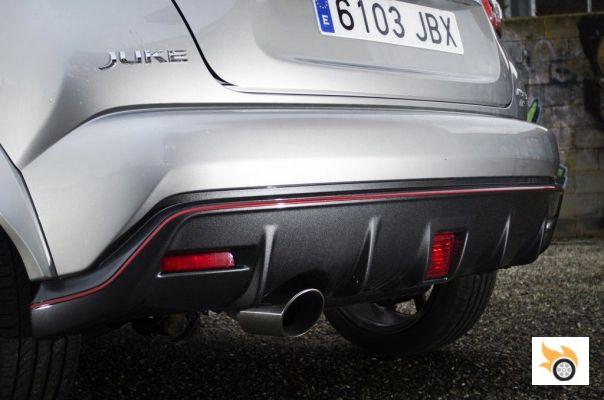
So yes, you can probably accelerate quicker than some of its rivals. On wet tarmac, or on broken tarmac in poor condition, the combination of traction and excellent suspension work make the Juke Nismo RS a real winner.
But those good points are once again overshadowed by the CVT gearbox. When accelerating and upshifting, it once again proves that it does what it wants. The gear ratio isn't fixed even with a virtual gear engaged, so you'll always notice a degree of slip. And since the car isn't a pure sprinter either, once you exit the corner, you won't feel like you're going "like a missile" either.
As Dani said with the "normal" Nismo, "it's a car to go fast, to enjoy at 80%, but not looking for the tickle". And for the RS, at least with this gearbox and transmission system, the same conclusion applies.
Conclusions
There are good things and not so good things about this Juke Nismo RS. Aesthetically it's different, yes, so it's a car that can get you through the eye. It's competent, acceptably quick and it's comfortable and versatile when it comes to manoeuvring. It's got a ton of power, so if you live in places where snow and rain are commonplace, it can have its advantages.
But it also has its downsides. It's tight on interior size and boot. The finish and choice of materials in the cabin is not up to the level of some price and segment rivals. And then, when you expect the RS acronym to add a dimension of radicalism and sportiness without complexes, it turns out that no, the car is still not a "hair-raising".
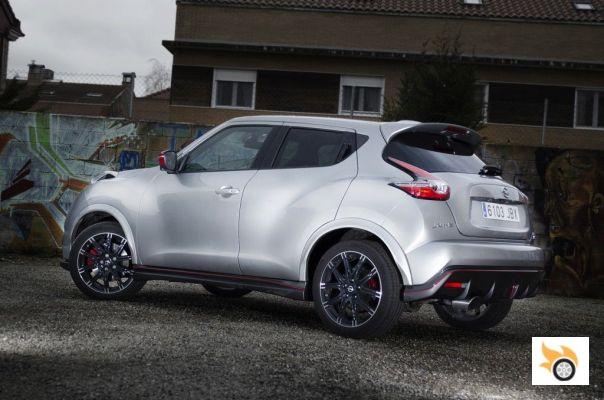
Probably all this has a lot to do with the variant tested and its choice of gearbox and transmission type. We were left with the desire to try the front-wheel drive, with manual gearbox and self-locking, wondering if that model is the one that will really get us smiles behind the wheel while facing curves in the port.
But until that question is answered, we'll tell you that if you're looking for a sports car to have a good time on a mountain road, the Juke Nismo RS is still no match for the "bogeymen" in the category (208 GTI 30th and Fiesta ST at the moment). However, if you're looking for a competent car, acceptably fast, different in aesthetics, and with a very good suspension tuning, the Juke Nismo RS may fit you, especially because the price-equipment ratio (23,700 with front-wheel drive and manual gearbox, 28,150 with CVT and all-wheel drive), is good. Of course, with what we've already told you about the CVT, and with more than £4,000 difference between the 4×2 and 4×4, I think there's no colour in the choice?
And all this while no other rival, with the exception of the not-quite-equivalent Countryman JCW (or Paceman JCW), has yet dared to get into the B-segment sports crossover business. How soon will they copy Nissan's recipe?
Article originally published on February 20, 2015, rescued for Pistonudos.
























